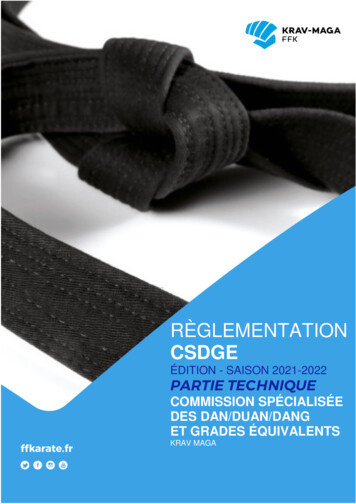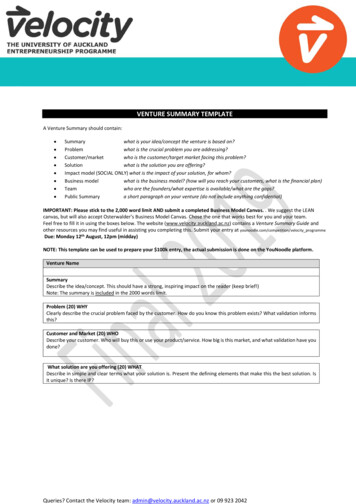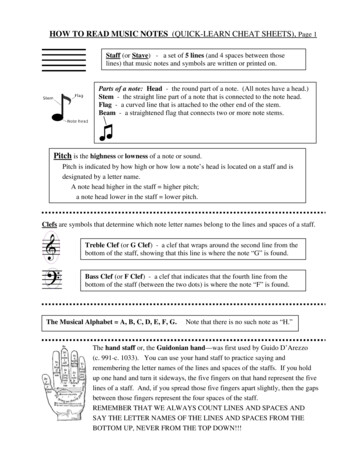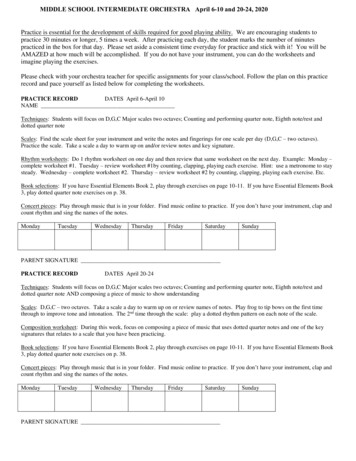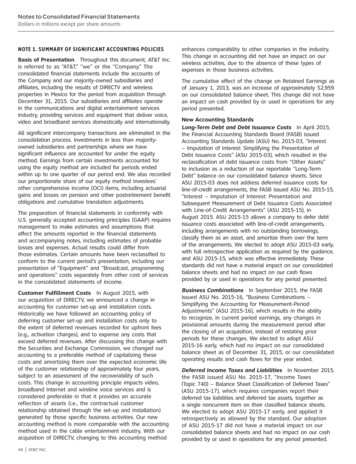
Transcription
Notes to Consolidated Financial StatementsDollars in millions except per share amountsNOTE 1. SUMMARY OF SIGNIFICANT ACCOUNTING POLICIESBasis of Presentation Throughout this document, AT&T Inc.is referred to as “AT&T,” “we” or the “Company.” Theconsolidated financial statements include the accounts ofthe Company and our majority-owned subsidiaries andaffiliates, including the results of DIRECTV and wirelessproperties in Mexico for the period from acquisition throughDecember 31, 2015. Our subsidiaries and affiliates operatein the communications and digital entertainment servicesindustry, providing services and equipment that deliver voice,video and broadband services domestically and internationally.All significant intercompany transactions are eliminated in theconsolidation process. Investments in less than majorityowned subsidiaries and partnerships where we havesignificant influence are accounted for under the equitymethod. Earnings from certain investments accounted forusing the equity method are included for periods endedwithin up to one quarter of our period end. We also recordedour proportionate share of our equity method investees’other comprehensive income (OCI) items, including actuarialgains and losses on pension and other postretirement benefitobligations and cumulative translation adjustments.The preparation of financial statements in conformity withU.S. generally accepted accounting principles (GAAP) requiresmanagement to make estimates and assumptions thataffect the amounts reported in the financial statementsand accompanying notes, including estimates of probablelosses and expenses. Actual results could differ fromthose estimates. Certain amounts have been reclassified toconform to the current period’s presentation, including ourpresentation of “Equipment” and “Broadcast, programmingand operations” costs separately from other cost of servicesin the consolidated statements of income.Customer Fulfillment Costs In August 2015, withour acquisition of DIRECTV, we announced a change inaccounting for customer set-up and installation costs.Historically we have followed an accounting policy ofdeferring customer set-up and installation costs only tothe extent of deferred revenues recorded for upfront fees(e.g., activation charges), and to expense any costs thatexceed deferred revenues. After discussing this change withthe Securities and Exchange Commission, we changed ouraccounting to a preferable method of capitalizing thesecosts and amortizing them over the expected economic lifeof the customer relationship of approximately four years,subject to an assessment of the recoverability of suchcosts. This change in accounting principle impacts video,broadband Internet and wireline voice services and isconsidered preferable in that it provides an accuratereflection of assets (i.e., the contractual customerrelationship obtained through the set-up and installation)generated by those specific business activities. Our newaccounting method is more comparable with the accountingmethod used in the cable entertainment industry. With ouracquisition of DIRECTV, changing to this accounting method46 AT&T INC.enhances comparability to other companies in the industry.This change in accounting did not have an impact on ourwireless activities, due to the absence of these types ofexpenses in those business activities.The cumulative effect of the change on Retained Earnings asof January 1, 2013, was an increase of approximately 2,959on our consolidated balance sheet. This change did not havean impact on cash provided by or used in operations for anyperiod presented.New Accounting StandardsLong-Term Debt and Debt Issuance Costs In April 2015,the Financial Accounting Standards Board (FASB) issuedAccounting Standards Update (ASU) No. 2015-03, “Interest– Imputation of Interest: Simplifying the Presentation ofDebt Issuance Costs” (ASU 2015-03), which resulted in thereclassification of debt issuance costs from “Other Assets”to inclusion as a reduction of our reportable “Long-TermDebt” balance on our consolidated balance sheets. SinceASU 2015-03 does not address deferred issuance costs forline-of-credit arrangements, the FASB issued ASU No. 2015-15,“Interest – Imputation of Interest: Presentation andSubsequent Measurement of Debt Issuance Costs Associatedwith Line-of-Credit Arrangements” (ASU 2015-15), inAugust 2015. ASU 2015-15 allows a company to defer debtissuance costs associated with line-of-credit arrangements,including arrangements with no outstanding borrowings,classify them as an asset, and amortize them over the termof the arrangements. We elected to adopt ASU 2015-03 early,with full retrospective application as required by the guidance,and ASU 2015-15, which was effective immediately. Thesestandards did not have a material impact on our consolidatedbalance sheets and had no impact on our cash flowsprovided by or used in operations for any period presented.Business Combinations In September 2015, the FASBissued ASU No. 2015-16, “Business Combinations –Simplifying the Accounting for Measurement-PeriodAdjustments” (ASU 2015-16), which results in the abilityto recognize, in current period earnings, any changes inprovisional amounts during the measurement period afterthe closing of an acquisition, instead of restating priorperiods for these changes. We elected to adopt ASU2015-16 early, which had no impact on our consolidatedbalance sheet as of December 31, 2015, or our consolidatedoperating results and cash flows for the year ended.Deferred Income Taxes and Liabilities In November 2015,the FASB issued ASU No. 2015-17, “Income Taxes(Topic 740) – Balance Sheet Classification of Deferred Taxes”(ASU 2015-17), which requires companies report theirdeferred tax liabilities and deferred tax assets, together asa single noncurrent item on their classified balance sheets.We elected to adopt ASU 2015-17 early, and applied itretrospectively as allowed by the standard. Our adoptionof ASU 2015-17 did not have a material impact on ourconsolidated balance sheets and had no impact on our cashprovided by or used in operations for any period presented.
The following tables present our results under our historical method and as adjusted to reflect these accounting changes:HistoricalAccounting MethodEffect ofVoluntary ChangeEffect of Adoptionof New ASUsAsAdjustedAt December 31, 2015 or for the year endedOther cost of servicesIncome tax expenseNet IncomeNet Income Attributable to AT&TBasic Earnings per Share Attributable to AT&TDiluted Earnings per Share Attributable to AT&T 36,0386,90813,52813,186 2.342.34 (256)97159159 0.030.03 ———— —— 35,7827,00513,68713,345 2.372.37Other current assetsOther AssetsLong-term debtDeferred income taxesTotal AssetsTotal LiabilitiesRetained earnings 12,22512,605118,83855,580398,889278,754 30,166 1,5883,064—1,1474,6521,147 3,505 (546)2(323)1(323)1(546)2(869)1,2(869)1,2 — 13,26715,346118,51556,181402,672279,032 33,671HistoricalAccounting MethodEffect ofVoluntary Change12Impact of ASU 2015-03.Impact of ASU 2015-17.Effect of Adoptionof New ASUsAsAdjustedAt December 31, 2014 or for the year endedOther cost of servicesOther income (expense) – netIncome tax expenseNet IncomeNet Income Attributable to AT&TBasic Earnings per Share Attributable to AT&TDiluted Earnings per Share Attributable to AT&T 37,5901,6523,4426,5186,224 1.191.19 (466)(71)177218218 0.050.05 ————— —— 37,1241,5813,6196,7366,442 1.241.24Other current assetsOther AssetsLong-term debtDeferred income taxesTotal AssetsTotal LiabilitiesRetained earnings 8,06710,99876,01137,544292,829205,905 27,736 1,7352,661—1,0054,3961,050 3,345 (157)2(234)1(233)1(113)2(391)1,2(391)1,2 — 9,64513,42575,77838,436296,834206,564 31,081HistoricalAccounting MethodEffect ofVoluntary Change12Impact of ASU 2015-03.Impact of ASU 2015-17.Effect of Adoptionof New ASUsAsAdjustedAt December 31, 2013 or for the year endedOther cost of servicesIncome tax expenseNet IncomeNet Income Attributable to AT&TBasic Earnings per Share Attributable to AT&TDiluted Earnings per Share Attributable to AT&T 31,5129,22418,55318,249 3.393.39 (273)104169169 0.030.03 ———— —— 31,2399,32818,72218,418 3.423.42Other current assetsOther AssetsLong-term debtDeferred income taxesTotal AssetsTotal LiabilitiesRetained earnings 5,9798,27869,29036,308277,787186,305 31,141 1,7252,269—8593,994866 3,128 (159)2(199)1(199)1(152)2(358)1,2(358)1,2 — 7,54510,34869,09137,015281,423186,813 34,26912Impact of ASU 2015-03.Impact of ASU 2015-17.AT&T INC. 47
Notes to Consolidated Financial Statements (continued)Dollars in millions except per share amountsRevenue Recognition In May 2014, the FASB issuedASU No. 2014-09, “Revenue from Contracts with Customers(Topic 606)” (ASU 2014-09) and has since modified thestandard with ASU 2015-14, “Deferral of the EffectiveDate.” These standards replace existing revenue recognitionrules with a comprehensive revenue measurement andrecognition standard and expanded disclosure requirements.ASU 2014-09 becomes effective for annual reportingperiods beginning after December 15, 2017, at which pointwe plan to adopt the standard. Upon initial evaluation,we believe the key changes in the standard that impactour revenue recognition relate to the allocation of contractrevenues between various services and equipment, andthe timing in which those revenues are recognized.We are still in the process of determining the impacton the timing of revenue recognition and the allocationof revenue to products and segments.ASU 2014-09 also specifies that all incremental costs ofobtaining and direct costs of fulfilling our contracts withcustomers should be deferred and recognized over thecontract period or expected customer life. In the third quarterof 2015, we changed our accounting policy for the costs offulfilling contracts with customers to defer all recoverablecosts while not changing our approach to acquisition costs.We believe, as a result of our accounting policy change forfulfillment costs, that the requirement to defer such costs inthe new standard will not result in a significant change to ourresults. The requirement to defer contract acquisition costshowever, will result in the recognition of a deferred charge onour balance sheets, but as the industry continues to undergochanges in how devices and services are sold to customerswith impacts on the resulting commissions paid to ourinternal and external salesforces, we cannot currentlyestimate impact of this change.The FASB allows two adoption methods under ASU 2014-09.Under one method, a company will apply the rules tocontracts in all reporting periods presented, subject tocertain allowable exceptions. Under the other method, acompany will apply the rules to all contracts existing as ofJanuary 1, 2018, recognizing in beginning retained earningsan adjustment for the cumulative effect of the change andprovide additional disclosures comparing results to previousrules. While we continue to evaluate the impact of thenew standard and available adoption methods, we believethe standard will require us to implement new revenueaccounting systems and processes, which will significantlychange our internal controls over revenue recognition.In addition, the implementation of the new systems andprocesses will impact our considerations of which adoptionmethods we intend to use.48 AT&T INC.Financial Instruments In January 2016, the FASB issuedASU No. 2016-01, “Financial Instruments – Overall (Subtopic825-10): Recognition and Measurement of Financial Assetsand Financial Liabilities” (ASU 2016-01), which will requireus to record changes in the fair value of our equityinvestments, except for those accounted for under the equitymethod, in net income instead of in accumulated othercomprehensive income. ASU 2016-01 will become effectivefor fiscal years and interim periods beginning afterDecember 15, 2017, and with the exception of certaindisclosure requirements, is not subject to early adoption.Income Taxes We provide deferred income taxes fortemporary differences between the carrying amounts ofassets and liabilities for financial reporting purposes andthe computed tax basis of those assets and liabilities.We provide valuation allowances against the deferred taxassets (included, together with our deferred income taxassets, as part of our reportable net deferred income taxliabilities on our consolidated balance sheets), for whichthe realization is uncertain. We review these items regularlyin light of changes in federal and state tax laws andchanges in our business.Cash and Cash Equivalents Cash and cash equivalentsinclude all highly liquid investments with originalmaturities of three months or less. The carrying amountsapproximate fair value. At December 31, 2015, we held 2,117 in cash and 3,004 in money market funds andother cash equivalents.Revenue Recognition Revenues derived from wireless,fixed telephone, data and video services are recognizedwhen services are provided. This is based upon either usage(e.g., minutes of traffic/bytes of data processed), period oftime (e.g., monthly service fees) or other established feeschedules. Our service revenues are billed either in advance,arrears or are prepaid.We record revenue reductions for estimated futureadjustments to customer accounts, other than bad debtexpense, at the time revenue is recognized based onhistorical experience. Service revenues include billingsto our customers for various regulatory fees imposed onus by governmental authorities. We report revenues fromtransactions between us and our customers net of taxesthe government authorities require us to collect fromour customers in our consolidated statements of income.Cash incentives given to customers are recorded as a
reduction of revenue. Revenues related to nonrefundable,upfront service activation and setup fees are deferred andrecognized over the associated service contract periodor customer life. Revenue recognized from contracts thatbundle services and equipment is limited to the lesserof the amount allocated based on the relative selling priceof the equipment and service already delivered or theamount paid and owed by the customer for the equipmentand service already delivered. We record the sale ofequipment to customers when we no longer have anyrequirements to perform, when title is passed and whenthe products are accepted by customers. We record thesale of equipment and services to customers as grossrevenue when we are the principal in the arrangementand net of the associated costs incurred when we arenot considered the principal in the arrangement.We offer to our customers the option to purchase certainwireless devices in installments over a period of up to30 months, with the right to trade in the original equipmentfor a new device, after having paid a specified numberof installments, and have the remaining unpaid balancesatisfied. For customers that elect these installment paymentprograms, we recognize revenue for the entire amount ofthe customer receivable, net of the fair value of the trade-inright guarantee and imputed interest. See Note 15 foradditional information, including the sales of our equipmentinstallment receivables.Allowance for Doubtful Accounts We record expenseto maintain an allowance for doubtful accounts forestimated losses that result from the failure or inabilityof our customers to make required payments deemedcollectable from the customer when the service wasprovided or product was delivered. When determiningthe allowance, we consider the probability of recoverabilityof accounts receivable based on past experience, takinginto account current collection trends as well as generaleconomic factors, including bankruptcy rates. Credit risks areassessed based on historical write-offs, net of recoveries, aswell as an analysis of the aged accounts receivable balanceswith allowances generally increasing as the receivable ages.Accounts receivable may be fully reserved for when specificcollection issues are known to exist, such as pendingbankruptcy or catastrophes.Inventory Inventories, which are included in “Other currentassets” on our consolidated balance sheets, were 4,033at December 31, 2015, and 1,933 at December 31, 2014.Wireless devices and accessories, which are valued atthe lower of cost or market (determined using currentreplacement cost), were 3,733 at December 31, 2015,and 1,858 at December 31, 2014.Property, Plant and Equipment Property, plant andequipment is stated at cost, except for assets acquiredusing acquisition accounting, which are initially recordedat fair value (see Note 6). The cost of additionsand substantial improvements to property, plantand equipment is capitalized, and includes internalcompensation costs for these projects; however, noncashactuarial gains or losses included in compensationcosts are excluded from amounts reported as “capitalexpenditures.” The cost of maintenance and repairs ofproperty, plant and equipment is charged to operatingexpenses. Property, plant and equipment costs aredepreciated using straight-line methods over theirestimated economic lives. Certain subsidiaries followcomposite group depreciation methodology. Accordingly,when a portion of their depreciable property, plant andequipment is retired in the ordinary course of business,the gross book value is reclassified to accumulateddepreciation, and no gain or loss is recognized on thedisposition of these assets.Property, plant and equipment is reviewed for recoverabilitywhenever events or changes in circumstances indicate thatthe carrying amount may not be recoverable. We recognizean impairment loss when the carrying amount of a longlived asset is not recoverable. The carrying amount of along-lived asset is not recoverable if it exceeds the sumof the undiscounted cash flows expected to result fromthe use and eventual disposition of the asset.The liability for the fair value of an asset retirementobligation is recorded in the period in which it is incurred ifa reasonable estimate of fair value can be made. In periodssubsequent to initial measurement, we recognize period-toperiod changes in the liability resulting from the passageof time and revisions to either the timing or the amountof the original estimate. The increase in the carrying valueof the associated long-lived asset is depreciated over thecorresponding estimated economic life.AT&T INC. 49
Notes to Consolidated Financial Statements (continued)Dollars in millions except per share amountsSoftware Costs We capitalize certain costs incurred inconnection with developing or obtaining internal-usesoftware. Capitalized software costs are included in“Property, Plant and Equipment” on our consolidatedbalance sheets. In addition, there is certain network softwarethat allows the equipment to provide the features andfunctions unique to the AT&T network, which we includein the cost of the equipment categories for financialreporting purposes.We amortize our capitalized software costs over a three-yearto five-year period, reflecting the estimated period duringwhich these assets will remain in service, which also alignswith the estimated useful lives used in the industry.Goodwill and Other Intangible Assets AT&T has fivemajor classes of intangible assets: goodwill, licenses, whichinclude Federal Communications Commission (FCC), otherwireless licenses and orbital slots, other indefinite-livedintangible assets, primarily made up of the AT&T andDIRECTV International trade names including SKY, customerlists and various other finite-lived intangible assets(see Note 7).Goodwill represents the excess of consideration paidover the fair value of net assets acquired in businesscombinations. FCC and wireless licenses (wireless licenses)provide us with the exclusive right to utilize certain radiofrequency spectrum to provide wireless communicationsservices. While wireless licenses are issued for a fixedperiod of time (generally 10 years), renewals of wirelesslicenses have occurred routinely and at nominal cost.Moreover, we have determined that there are currentlyno legal, regulatory, contractual, competitive, economicor other factors that limit the useful lives of our wirelesslicenses. Orbital slots represent the space in which weoperate the broadcast satellites that support our digitalvideo entertainment service offerings. Similar to ourwireless licenses, there are no factors that limit the usefullives of our orbital slots. We acquired the rights to theAT&T and other brand names in previous acquisitions.We have the effective ability to retain these exclusiverights permanently at a nominal cost.Goodwill, licenses and other indefinite-lived intangibleassets are not amortized but are tested at least annuallyfor impairment. The testing is performed on the value asof October 1 each year, and compares the book value of50 AT&T INC.the assets to their fair value. Goodwill is tested bycomparing the book value of each reporting unit, deemedto be our principal operating segments or one levelbelow them (Business Solutions, Entertainment Group,Consumer Mobility, and Mexico Wireless, Brazil andPanAmericana in the International segment), to the fairvalue of those reporting units calculated using a discountedcash flow approach as well as a market multiple approach.Licenses are tested for impairment on an aggregate basis,consistent with our use of the licenses on a nationalscope using a discounted cash flow approach. We alsocorroborated the value of wireless licenses with a marketapproach as the AWS-3 auction provided market priceinformation for national wireless licenses. Brand namesare tested by comparing the book value to a fair valuecalculated using a discounted cash flow approach on apresumed royalty rate derived from the revenues relatedto the brand name.Intangible assets that have finite useful lives are amortizedover their useful lives (see Note 7). Customer lists andrelationships are amortized using primarily the sum-of-themonths-digits method of amortization over the period inwhich those relationships are expected to contribute to ourfuture cash flows. The remaining finite-lived intangible assetsare generally amortized using the straight-line method.Broadcast Programming and Other Costs We recognizethe costs of television programming distribution rightswhen we distribute the related programming. Werecognize the costs of television programming rights todistribute live sporting events to expense using thestraight-line method over the course of the season ortournament, which approximates the pattern of usage.Advertising Costs We expense advertising costs forproducts and services or for promoting our corporateimage as we incur them (see Note 18).Traffic Compensation Expense We use variousestimates and assumptions to determine the amountof traffic compensation expense recognized duringany reporting period. Switched traffic compensationcosts are accrued utilizing estimated rates andvolumes by product, formulated from historicaldata and adjusted for known rate changes. Suchestimates are adjusted monthly to reflect newlyavailable information, such as rate changes and
new contractual agreements. Bills reflecting actualincurred information are generally not received withinthree months subsequent to the end of the reportingperiod, at which point a final adjustment is made tothe accrued switched traffic compensation expense.Dedicated traffic compensation costs are estimatedbased on the number of circuits and the averageprojected circuit costs.Foreign Currency Translation We are exposed toforeign currency exchange risk through our foreignaffiliates and equity investments in foreign companies.Our foreign subsidiaries and foreign investmentsgenerally report their earnings in their local currencies.We translate their foreign assets and liabilities atexchange rates in effect at the balance sheet dates.We translate their revenues and expenses using averagerates during the year. The resulting foreign currencytranslation adjustments are recorded as a separatecomponent of accumulated other comprehensive income(accumulated OCI) in the accompanying consolidatedbalance sheets (see Note 3). Operations in countries withhighly inflationary economies consider the U.S. dollar asthe functional currency.We do not hedge foreign currency translation risk in thenet assets and income we report from these sources.However, we do hedge a portion of the foreign currencyexchange risk involved in anticipation of highly probableforeign currency-denominated transactions, which weexplain further in our discussion of our methods ofmanaging our foreign currency risk (see Note 10).Pension and Other Postretirement BenefitsSee Note 12 for a comprehensive discussion of ourpension and postretirement benefit expense, includinga discussion of the actuarial assumptions, our policyfor recognizing the associated gains and losses andour method used to estimate service and interestcost components.NOTE 2. EARNINGS PER SHAREA reconciliation of the numerators and denominators ofbasic earnings per share and diluted earnings per share isshown in the table below:Year Ended December 31,NumeratorsNumerator for basic earningsper share:Net incomeLess: Net income attributableto noncontrolling interestNet income attributable to AT&TDilutive potentialcommon shares:Share-based paymentNumerator for diluted earningsper shareDenominators (000,000)Denominator for basic earningsper share:Weighted-average number ofcommon shares outstandingDilutive potential commonshares:Share-based payment(in shares)Denominator for dilutedearnings per share2015 13,687(342)13,34513 13,35820142013 6,736 18,722(294)6,442(304)18,4181313 6,455 18,4315,6285,2055,3681816175,6465,2215,385Basic earnings per shareattributable to AT&T 2.37 1.24 3.42Diluted earnings per shareattributable to AT&T 2.37 1.24 3.42AT&T INC. 51
Notes to Consolidated Financial Statements (continued)Dollars in millions except per share amountsNOTE 3. OTHER COMPREHENSIVE INCOMEChanges in the balances of each component included in accumulated OCI are presented below. All amounts are net of taxand exclude noncontrolling interest.Following our 2015 acquisitions of DIRECTV and wireless businesses in Mexico, we have additional foreign operations that areexposed to fluctuations in the exchange rates used to convert operations, assets and liabilities into U.S. dollars. Since thedates of acquisition, when compared to the U.S. dollar, the Brazilian real exchange rate has depreciated 15.2%, the Argentinianpeso exchange rate has depreciated 29.1% and Mexican peso exchange rate has depreciated 13.1%. For the year endedDecember 31, 2014, the amounts reclassified from accumulated OCI include amounts realized upon the sale of ourinvestment in América Móvil, S.A. de C.V. (América Móvil) (see Note 5).At December 31, 2015, 2014 and 2013 and for the years endedBalance as of December 31, 2012Other comprehensive income (loss)before reclassificationsAmounts reclassified from accumulated OCINet other comprehensive income (loss)Balance as of December 31, 2013Other comprehensive income (loss)before reclassificationsAmounts reclassified from accumulated OCINet other comprehensive income (loss)Balance as of December 31, 2014Other comprehensive income (loss)before reclassificationsAmounts reclassified from accumulated OCINet other comprehensive income (loss)Balance as of December 31, 20151234ForeignCurrencyTranslationAdjustment (284)Net UnrealizedGains (Losses) onAvailable-forSale SecuritiesNet UnrealizedGains (Losses)on Cash atedOtherComprehensiveIncome 271 (110) 5,358 (497)1818,061(1,172)—1(1,172) (1,198)—(15)2(15) 484(763)383(725) 1645(860)4(815) 6,032(1,890)(837)(2,727) 5,334Translation (gain) loss reclassifications are included in Other income (expense) – net in the consolidated statements of income.(Gains) losses are included in Other income (expense) – net in the consolidated statements of income.(Gains) losses are included in interest expense in the consolidated statements of income. See Note 10 for additional information. The amortization of prior service credits associated with postretirement benefits, net of amounts capitalized as part of construction labor, are included in Cost of servicesand sales and Selling, general and administrative in the consolidated statements of income (see Note 12). Actuarial loss reclassifications related to our equity methodinvestees are included in Other income (expense) – net in the consolidated statements of income.NOTE 4. SEGMENT INFORMATIONOur segments are strategic business units that offerproducts and services to different customer segments overvarious technology platforms and/or in different geographiesthat are managed accordingly. Due to recent organizationalchanges and our July 24, 2015 acquisition of DIRECTV,effective for the quarter ended September 30, 2015, werevised our operating segments to align with our newmanagement structure and organizational responsibilities.We analyze our operating segments based on segmentcontribution, which consists of operating income, excludingacquisition-related costs and other significant items(as discussed below), and equity in net income of affiliatesfor investments managed within each operating segment.We have four reportable segments: (1) Business Solutions,(2) Entertainment Group, (3) Consumer Mobility and(4) International.52 AT&T INC.We also evaluate segment performance based on segmentoperating income before depreciation and amortization,which we refer to as EBITDA and/or EBITDA margin. Webelieve EBITDA to be a relevant and useful measurementto our investors as it is part of our internal managementreporting and planning processes and it is an importantmetric that management uses to evaluate segmento
Revenue Recognition In May 2014, the FASB issued ASU No. 2014-09, "Revenue from Contracts with Customers (Topic 606)" (ASU 2014-09) and has since modified the standard with ASU 2015-14, "Deferral of the Effective Date." These standards replace existing revenue recognition rules with a comprehensive revenue measurement and





